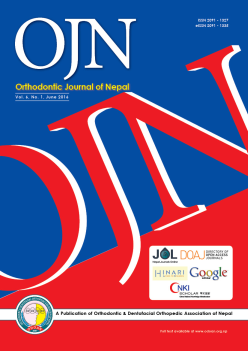Frictional Resistance in Various Ceramic Brackets using Archwires of different Alloys, Sizes and Cross sections: A Comparative Study
DOI:
https://doi.org/10.3126/ojn.v6i1.16174Keywords:
archwire, ceramic brackets, friction, self-ligating bracketAbstract
Introduction: Friction at the bracket-archwire interface has been observed as one of the most important factors affecting tooth movement. Hence it is importance to assess the friction generated during tooth movement to bring about optimal treatment results.
Objective: To compare the frictional resistance of various ceramic brackets using different archwires, and to compare the static and kinetic frictional force of various ceramic brackets using different archwires.
Materials & Method: The present study evaluated and compared the friction generated at the bracket archwire interface when 0.018” and 0.019”x0.025” stainless steel archwires and 0.019”x0.025” teflon coated stainless steel archwires were moved through conventionally ligated, passive self-ligating and interactive self-ligating ceramic brackets. The static and kinetic frictional forces were also evaluated and compared.
Result: Highly significant differences in kinetic (p<0.001) and static (p<0.001) frictional forces were observed in all three groups when used with the different archwires. On comparing the static and kinetic frictional forces significant differences were observed among all three groups (p<0.05).
Conclusion: The passive self-ligating brackets produce the least frictional forces when compared to interactive self-ligating and conventionally ligated brackets. Also, the static frictional forces were found to be more as compared to kinetic frictional forces.
Orthodontic Journal of Nepal, Vol. 6 No. 1, June 2016, pp.18-22
Downloads
Downloads
Published
How to Cite
Issue
Section
License
Copyright © held by Orthodontic & Dentofacial Orthopedic Association of Nepal
- Copyright on any research article is transferred in full to the Orthodontic & Dentofacial Orthopedic Association of Nepal upon publication in the journal. The copyright transfer includes the right to reproduce and distribute the article in any form of reproduction (printing, electronic media or any other form).
- Articles in the Orthodontic Journal of Nepal are Open Access articles published under the Creative Commons CC BY License (https://creativecommons.org/licenses/by/4.0/)
- This license permits use, distribution and reproduction in any medium, provided the original work is properly cited.




